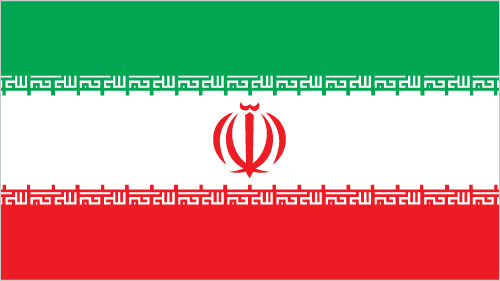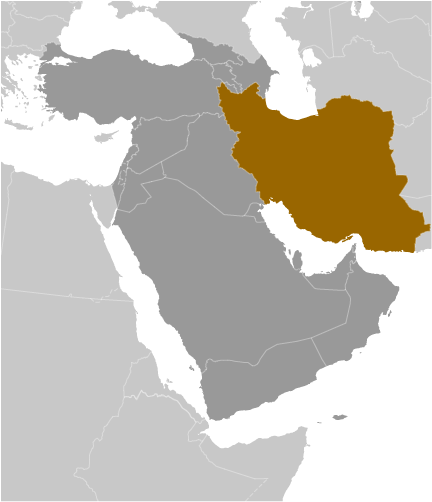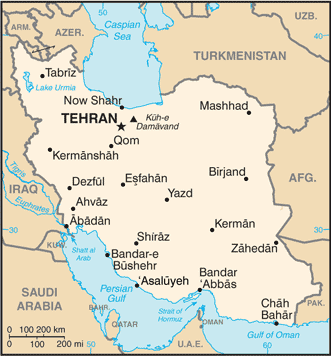|
Country name:
|

|
|
conventional long form: Islamic Republic of Iran
conventional short form:
Iran
local long form:
Jomhuri-ye Eslami-ye Iran
local short form:
Iran
former:
Persia
|
|
|
Government type:
|

|
|
theocratic republic
|
|
|
Capital:
|

|
|
name: Tehran
geographic coordinates:
35 42 N, 51 25 E
time difference:
UTC+3.5 (8.5 hours ahead of Washington, DC during Standard Time)
daylight saving time:
+1hr, begins fourth Tuesday in March; ends fourth Thursday in September
|
|
|
Administrative divisions:
|

|
|
31 provinces (ostanha, singular - ostan); Alborz, Ardabil, Azarbayjan-e Gharbi (West Azerbaijan), Azarbayjan-e Sharqi (East Azerbaijan), Bushehr, Chahar Mahal va Bakhtiari, Esfahan, Fars, Gilan, Golestan, Hamadan, Hormozgan, Ilam, Kerman, Kermanshah, Khorasan-e Jonubi (South Khorasan), Khorasan-e Razavi (Razavi Khorasan), Khorasan-e Shomali (North Khorasan), Khuzestan, Kohgiluyeh va Bowyer Ahmad, Kordestan, Lorestan, Markazi, Mazandaran, Qazvin, Qom, Semnan, Sistan va Baluchestan, Tehran, Yazd, Zanjan
|
|
|
Independence:
|

|
|
1 April 1979 (Islamic Republic of Iran proclaimed); notable earlier dates: ca. 625 B.C. (unification of Iran under the Medes); ca. A.D. 1501 (Iran reunified under the Safavids); 12 December 1925 (modern Iran established under the Pahlavis)
|
|
|
National holiday:
|

|
|
Republic Day, 1 April (1979)
|
|
|
Constitution:
|

|
|
2-3 December 1979; revised 1989
note:
the revision in 1989 expanded powers of the presidency and eliminated the prime ministership
|
|
|
Legal system:
|

|
|
religious legal system based on sharia law
|
|
|
International law organization participation:
|

|
|
has not submitted an ICJ jurisdiction declaration; non-party state to the ICCt
|
|
|
Suffrage:
|

|
|
18 years of age; universal
|
|
|
Executive branch:
|

|
|
chief of state: Supreme Leader Ali Hoseini-KHAMENEI (since 4 June 1989)
head of government:
President Mahmud AHMADI-NEJAD (since 3 August 2005); First Vice President Mohammad Reza RAHIMI (since 13 September 2009)
cabinet:
Council of Ministers selected by the president with legislative approval; the Supreme Leader has some control over appointments to the more sensitive ministries
(For more information visit the World Leaders website  ) )
note:
also considered part of the Executive branch of government are three oversight bodies: 1) Assembly of Experts (Majles-e Khoebregan), a popularly elected body charged with determining the succession of the Supreme Leader, reviewing his performance, and deposing him if deemed necessary; 2) Expediency Council or the Council for the Discernment of Expediency (Majma-ye- Tashkhis-e -Maslahat-e- Nezam) exerts supervisory authority over the executive, judicial, and legislative branches and resolves legislative issues when the Majles and the Council of Guardians disagree and since 1989 has been used to advise national religious leaders on matters of national policy; in 2005 the Council's powers were expanded to act as a supervisory body for the government; 3) Council of Guardians of the Constitution or Council of Guardians or Guardians Council (Shora-ye Negban-e Qanon-e Asasi) determines whether proposed legislation is both constitutional and faithful to Islamic law, vets candidates in popular elections for suitability, and supervises national elections
elections:
supreme leader appointed for life by the Assembly of Experts; president elected by popular vote for a four-year term (eligible for a second term and additional nonconsecutive term); election last held on 14 June 2009 (next presidential election to be held in June 2013)
election results:
Mahmud AHMADI-NEJAD reelected president; percent of vote - Mahmud AHMADI-NEJAD 62.6%, Mir-Hosein MUSAVI-Khamenei 33.8%, other 3.6%; voter turnout 85% (according to official figures published by the government)
|
|
|
Legislative branch:
|

|
|
unicameral Islamic Consultative Assembly or Majles-e Shura-ye Eslami or Majles (290 seats; members elected by popular vote from single and multimember districts to serve four-year terms)
elections:
last held on 2 March 2012 (first round); second round held on 4 May 2012; (next election to be held in 2016)
election results:
percent of vote by party - NA; seats by party - NA
|
|
|
Judicial branch:
|

|
|
The Supreme Court (Qeveh Qazaieh) and the four-member High Council of the Judiciary have a single head and overlapping responsibilities; together they supervise the enforcement of all laws and establish judicial and legal policies; lower courts include a special clerical court, a revolutionary court, and a special administrative court
|
|
|
Political parties and leaders:
|

|
|
Note: formal political parties are a relatively new phenomenon in Iran and most conservatives still prefer to work through political pressure groups rather than parties; often political parties or coalitions are formed prior to elections and disbanded soon thereafter; a loose pro-reform coalition called the 2nd Khordad Front, which includes political parties as well as less formal groups and organizations, achieved considerable success in elections for the sixth Majles in early 2000; groups in the coalition included the Islamic Iran Participation Front (IIPF), Executives of Construction Party (Kargozaran), Solidarity Party, Islamic Labor Party, Mardom Salari, Mojahedin of the Islamic Revolution Organization (MIRO), and Militant Clerics Society (MCS; Ruhaniyun); the coalition participated in the seventh Majles elections in early 2004 but boycotted them after 80 incumbent reformists were disqualified; following his defeat in the 2005 presidential elections, former MCS Secretary General and sixth Majles Speaker Mehdi KARUBI formed the National Trust Party; a new conservative group, Islamic Iran Developers Coalition (Abadgaran), took a leading position in the new Majles after winning a majority of the seats in February 2004; ahead of the 2008 Majles elections, traditional and hardline conservatives attempted to close ranks under the United Front of Principlists and the Broad Popular Coalition of Principlists; several reformist groups, such as the MIRO and the IIPF, also came together as a reformist coalition in advance of the 2008 Majles elections; the IIPF has repeatedly complained that the overwhelming majority of its candidates were unfairly disqualified from the 2008 elections
|
|
|
Political pressure groups and leaders:
|

|
|
groups that generally support the Islamic Republic: Ansar-e Hizballah-; Followers of the Line of the Imam and the Leader; Islamic Coalition Party (Motalefeh); Islamic Engineers Society; Tehran Militant Clergy Association (MCA; Ruhaniyat)
active pro-reform student group:
Office of Strengthening Unity (OSU)
opposition groups:
Freedom Movement of Iran; Green Path movement [Mehdi KARUBI, Mir-Hosein MUSAVI]; Marz-e Por Gohar; National Front; various ethnic and monarchist organizations
armed political groups repressed by the government:
Democratic Party of Iranian Kurdistan (KDPI); Jundallah; Komala; Mojahedin-e Khalq Organization (MEK or MKO); People's Fedayeen; People's Free Life Party of Kurdistan (PJAK)
|
|
|
International organization participation:
|

|
|
CICA, CP, D-8, ECO, FAO, G-15, G-24, G-77, IAEA, IBRD, ICAO, ICC (national committees), ICRM, IDA, IDB, IFAD, IFC, IFRCS, IHO, ILO, IMF, IMO, IMSO, Interpol, IOC, IOM, IPU, ISO, ITSO, ITU, MIGA, NAM, OIC, OPCW, OPEC, PCA, SAARC (observer), SCO (observer), UN, UNAMID, UNCTAD, UNESCO, UNHCR, UNIDO, UNITAR, UNWTO, UPU, WCO, WFTU (NGOs), WHO, WIPO, WMO, WTO (observer)
|
|
|
Diplomatic representation in the US:
|

|
|
none; note - Iran has an Interests Section in the Pakistani Embassy; address: Iranian Interests Section, Pakistani Embassy, 2209 Wisconsin Avenue NW, Washington, DC 20007; telephone: [1] (202) 965-4990; FAX [1] (202) 965-1073
|
|
|
Diplomatic representation from the US:
|

|
|
none; note - the US Interests Section is located in the Embassy of Switzerland No. 39 Shahid Mousavi (Golestan 5th), Pasdaran Ave., Tehran, Iran; telephone [98] 21 2254 2178/2256 5273; FAX [98] 21 2258 0432
|
|
|
Flag description:
|

|
|
three equal horizontal bands of green (top), white, and red; the national emblem (a stylized representation of the word Allah in the shape of a tulip, a symbol of martyrdom) in red is centered in the white band; ALLAH AKBAR (God is Great) in white Arabic script is repeated 11 times along the bottom edge of the green band and 11 times along the top edge of the red band; green is the color of Islam and also represents growth, white symbolizes honesty and peace, red stands for bravery and martyrdom
|
|
|
National symbol(s):
|

|
|
lion
|
|
|
National anthem:
|

|
|
name: "Soroud-e Melli-ye Jomhouri-ye Eslami-ye Iran" (National Anthem of the Islamic Republic of Iran)
lyrics/music:
multiple authors/Hassan RIAHI
note:
adopted 1990
|
|
|
|
|





 )
)



